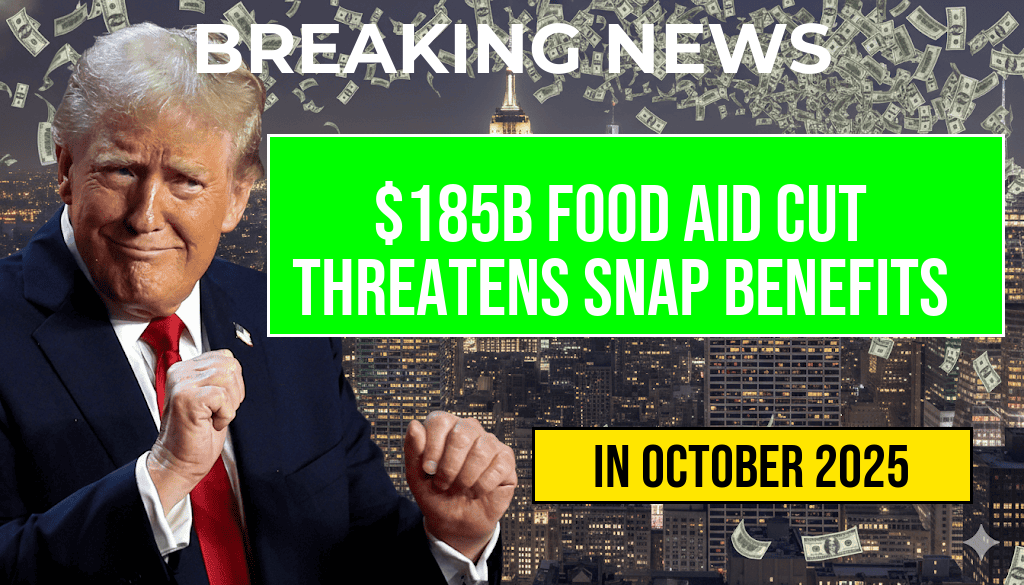Shaking Safety Net: $185 Billion Cut from Food Aid Raises Concerns Over Your $546 Two-Person SNAP Benefits
A proposed federal budget reduction totaling approximately $185 billion over the next decade is fueling debate over the future of the Supplemental Nutrition Assistance Program (SNAP). This significant cut threatens to reshape the safety net that supports millions of Americans facing food insecurity, with critics warning that vulnerable households could see their benefits shrink considerably. For a typical two-person household, the average SNAP benefit currently stands at around $546 per month, providing crucial assistance to cover grocery expenses. As policymakers debate the merits of fiscal austerity versus social safety, community advocates and economists warn that slashing food aid risks exacerbating hunger and worsening health outcomes among low-income families.
Understanding the Scope of the Proposed Cuts
The proposed budget, introduced by federal lawmakers, aims to trim federal spending by redirecting funds from various social programs, including SNAP. The $185 billion figure encompasses a combination of policy changes such as tightening eligibility criteria, reducing benefit levels, and implementing stricter work requirements. These measures are intended to curb program abuse and incentivize employment, but critics argue they could have unintended consequences.
According to estimates from the Center on Budget and Policy Priorities (CBPP), such reductions could result in millions of Americans losing access to vital nutrition assistance, with some studies projecting a decline in average benefits by as much as 20%. For households already living on the edge, this could mean the difference between putting food on the table or facing hunger.
The Impact on Two-Person Households
For a typical couple relying on SNAP, the current average benefit of $546 per month provides essential support. The proposed cuts could reduce that amount significantly, depending on household income and eligibility adjustments.
| Household Type | Current Average Benefit | Projected Benefit Post-Cuts | Potential Monthly Reduction |
|---|---|---|---|
| Two-Person Household | $546 | $450 (estimated) | $96 |
This reduction could translate into difficulty meeting basic nutritional needs, forcing families to make tough choices between food, housing, and healthcare.
Broader Implications for Food Security
Food insecurity in the United States remains a persistent challenge, with approximately 11% of households experiencing limited or uncertain access to adequate food, according to the USDA. SNAP is a cornerstone of federal efforts to combat hunger, with nearly 42 million Americans relying on it each month. The program not only alleviates immediate hunger but also supports local economies by increasing demand for retail food sales.
Reducing SNAP benefits risks reversing years of progress in reducing hunger. Studies have linked diminished food assistance to poorer health outcomes, increased emergency room visits, and higher incidences of chronic diseases such as diabetes and hypertension among low-income populations.
Community and Economic Concerns
Local organizations and advocacy groups warn that the proposed cuts could have ripple effects beyond individual households. Reduced benefits may lead to increased reliance on emergency food banks and charitable organizations, further straining community resources.
“Cutting food assistance at this scale is a step backward,” said Maria Lopez, director of a community food bank in Chicago. “Our clients are already making tough choices—these reductions could push families into deeper hardship.”
Economists also warn that slashing SNAP funding may slow economic recovery. Food benefits tend to be spent quickly and locally, providing an immediate boost to grocery stores and local farmers. Removing or reducing this safety net could dampen retail sales and hinder job growth in food retail sectors.
Policy Perspectives and Future Outlook
Supporters of the budget proposal argue that fiscal responsibility necessitates reducing government spending and promoting self-sufficiency among recipients. They cite concerns over program dependency and aim to reorient welfare policies toward employment and economic independence.
Opponents, however, emphasize that the timing of such cuts could be especially damaging amid ongoing economic uncertainties, including inflation and labor shortages. They advocate for targeted reforms that improve program efficiency without sacrificing the core goal of reducing hunger.
As legislative negotiations continue, the fate of SNAP funding remains uncertain. The upcoming Congressional debates are expected to determine whether these proposed reductions will materialize or be modified to protect vulnerable populations.
Resources and Further Reading
- Wikipedia: Supplemental Nutrition Assistance Program
- Center on Budget and Policy Priorities – Food Assistance
- USDA SNAP Benefits Overview
Frequently Asked Questions
What is the main concern regarding the $185 billion cut from food aid?
The primary concern is that the significant cut will drastically reduce food assistance for millions of Americans, potentially leading to increased hunger and food insecurity.
How will the $185 billion reduction impact the average SNAP benefits for a two-person household?
The reduction is expected to lower the average SNAP benefits from $546 to a level that may not fully cover basic food needs, putting vulnerable families at greater risk of malnutrition.
Why are there concerns over the safety net provided by SNAP due to these cuts?
Experts worry that the shrinking food assistance safety net will leave many families unable to afford nutritious food, especially during economic downturns or emergencies.
Who is most affected by the proposed food aid cuts?
Low-income families, elderly individuals, and people with disabilities are most vulnerable to the reduction in food assistance, risking increased hardship and food insecurity.
Are there any measures or programs to mitigate the impact of these cuts?
Currently, policymakers are debating alternative support strategies, but without intervention, the significant cut will likely lead to a substantial loss of aid for many Americans relying on SNAP.

Leave a Reply